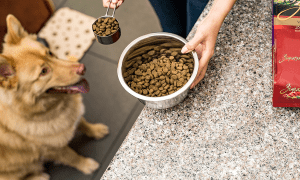“This post contains affiliate links, and I will be compensated if you make a purchase after clicking on my links.”

This doesn’t mean, however, that your dog is not trying to communicate with you and that there is no way for you to understand what he needs. Because we are largely a vocal species that uses our voices to communicate, we sometimes forget that body language is just as important as spoken language. And while dogs do learn the meanings of certain words (like “walk,” “food,” “toy,” “treat,” etc.), we are usually not as good at learning what their barking means. Here are some ways to listen to what your dog does tell you:
Pay attention to his body language.
Unlike humans that might try to mask their body language or put on a face, your dog will never try to deceive you with his body language. He wants you to know what he’s thinking and feeling, especially when he is happy or uncomfortable. If you want to know what your dog is saying, pay attention to his body language. A wagging tail and relaxed body usually means that he is happy or at least content. Bared teeth and raised hackles means that he is sensing danger. Panting or exaggerated yawning can mean that he is nervous and is trying to calm down. These cues and others are great ways to listen to your dog.
Pay attention to what he does.
For example, if you are trying to introduce your dog to another dog and he seems to be uncomfortable, if he is hiding behind your legs or simply retreating from the dog or person, this is a pretty good indication that he does not want to do what you are forcing him to do. And while sometimes these interactions are necessary (if you are introducing another dog into the home or are trying to take your dog to the vet), if you are in a casual situation that your dog is obviously not enjoying, it is probably not a good idea to force him to continue to do that thing.
Notice what he likes and doesn’t like.
Just because something is labeled a treat does not mean that your dog is going to love it. Just like humans, many dogs are very picky about what they do or do not like. Your dog might prefer crunchy treats or only like chewy treats. Older dogs might have a hard time with crunchy treats, while younger dogs will probably enjoy the crunch. Some might love the vegetable flavors while others might only like the meaty flavors. If he seems less enthusiastic about some kinds of food or treats, this is a pretty good indication that he does not like those as much as he likes other food and treats.
Pay attention to whether or not your dog is training you.
Your dog can train you just as easily as you can train your dog. Dogs are smart—often smarter than they are given credit for. And your dog can train you to take him on a walk or give him a treat or attention by exhibiting a certain behavior—usually a negative behavior. You do not want your dog to train you, so pay attention to not just what he is doing, but why he is doing it. He’ll learn that he can consistently get a certain reaction out of you. Listening to him in this way will make sure that you’re the one doing the training, not the other way around.
Jillian Vogel is the owner at Gulf Coast K9 Dog Training in Bradenton, Florida. Originally from the Buffalo NY area, Jillian entered the dog training industry to follow her love for dogs and animals in general. She is passionate about helping dogs overcome hurdles and obstacles, and helping people to live a better life with their best friend.





















